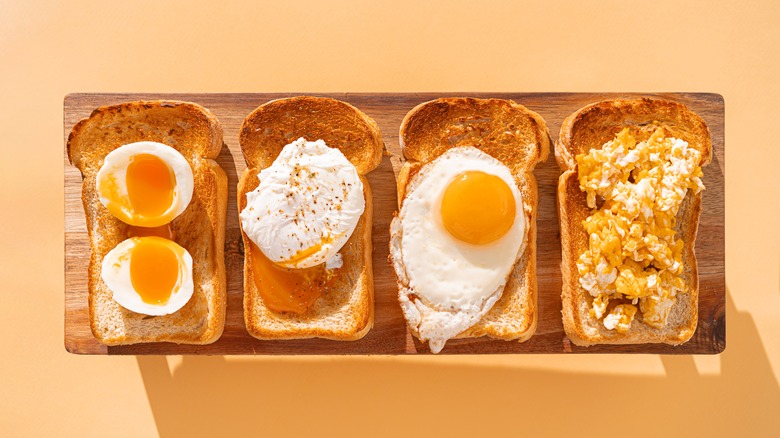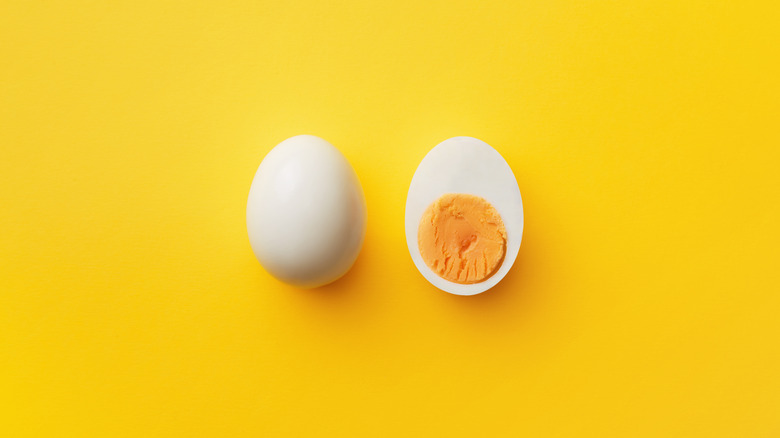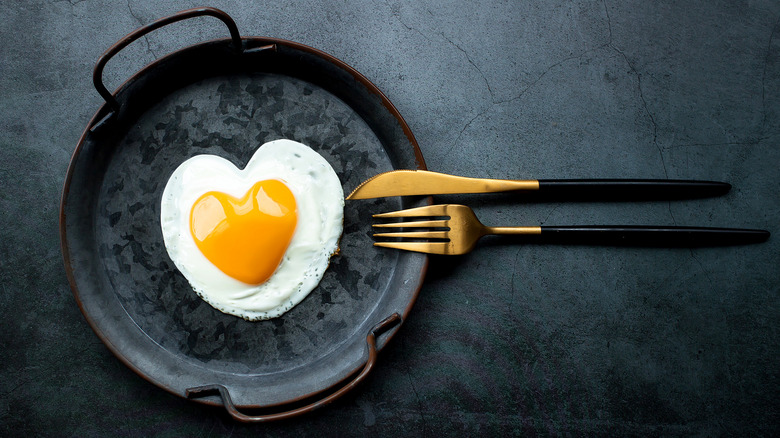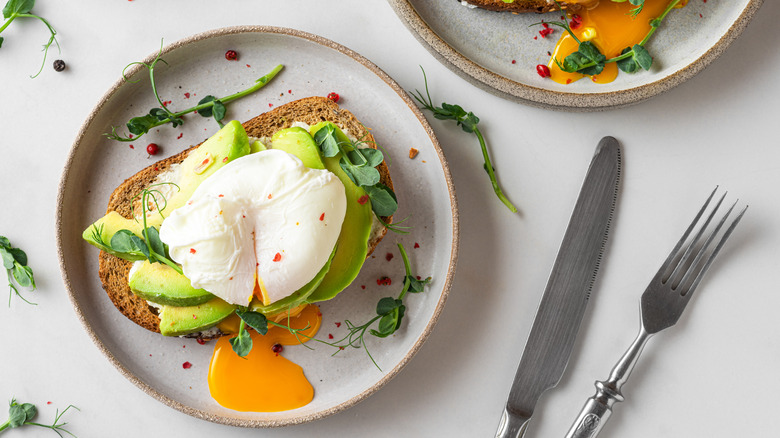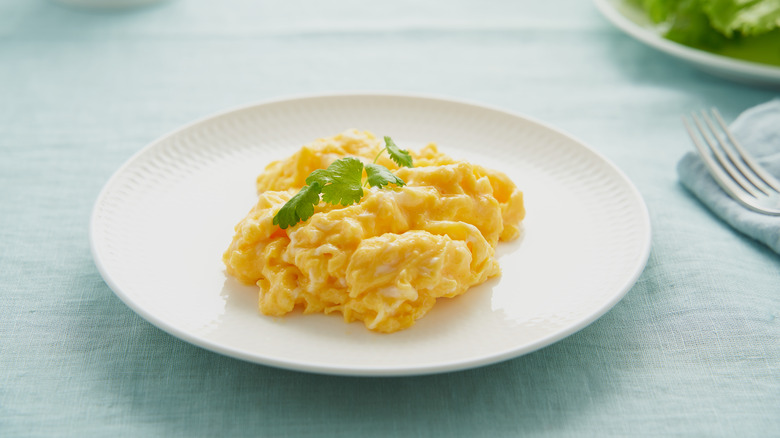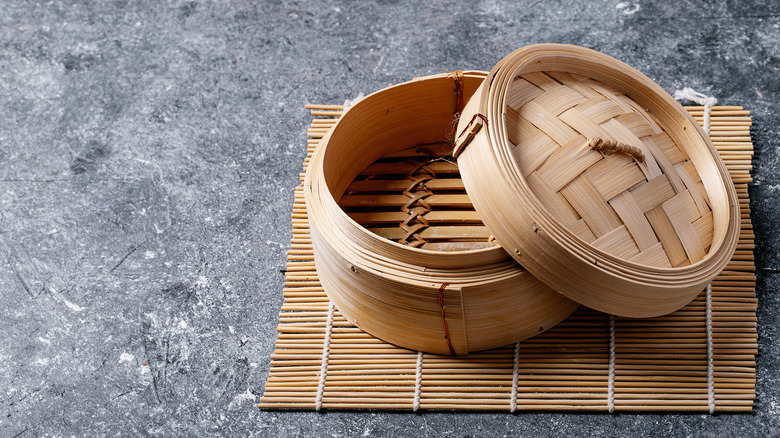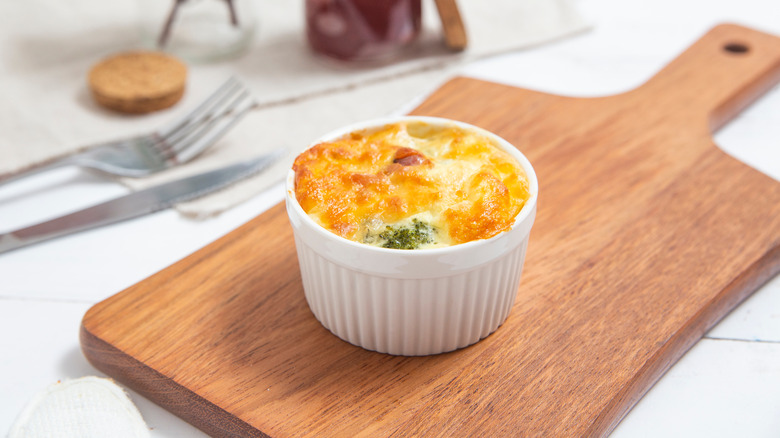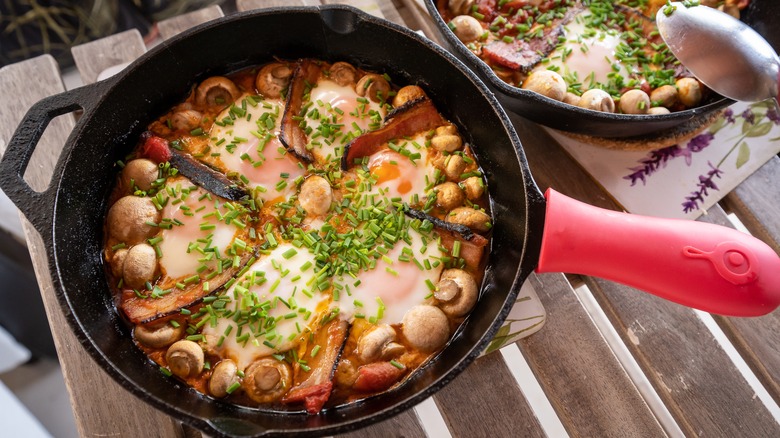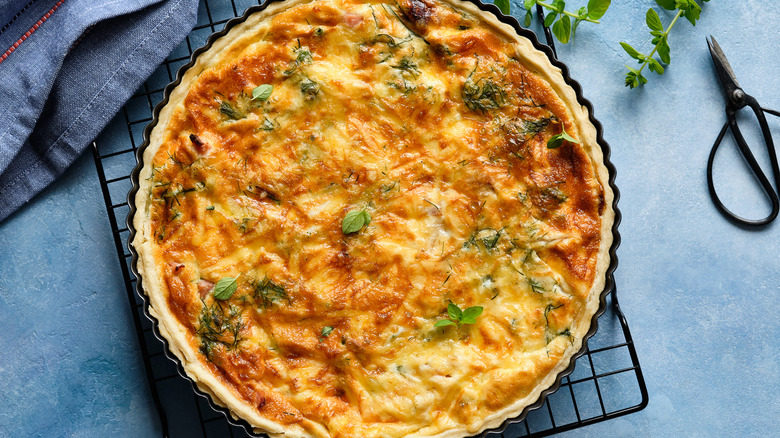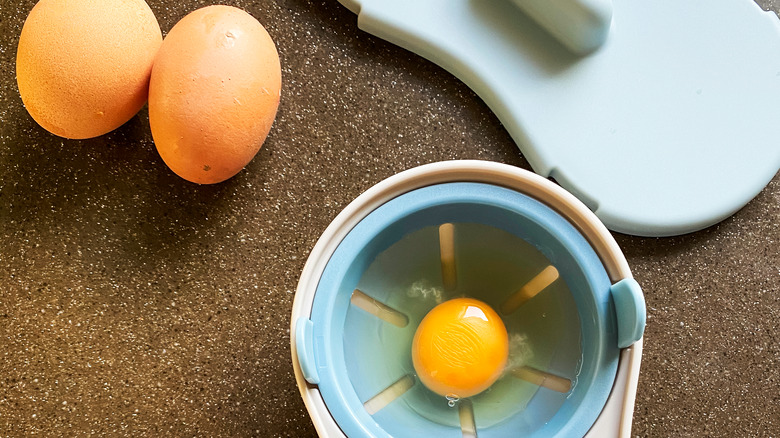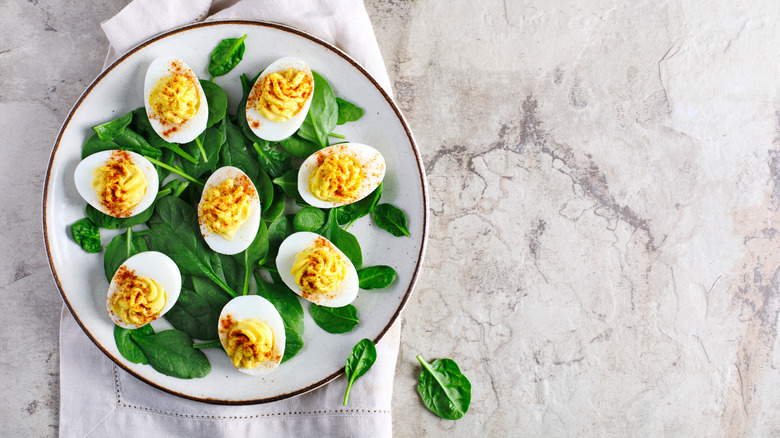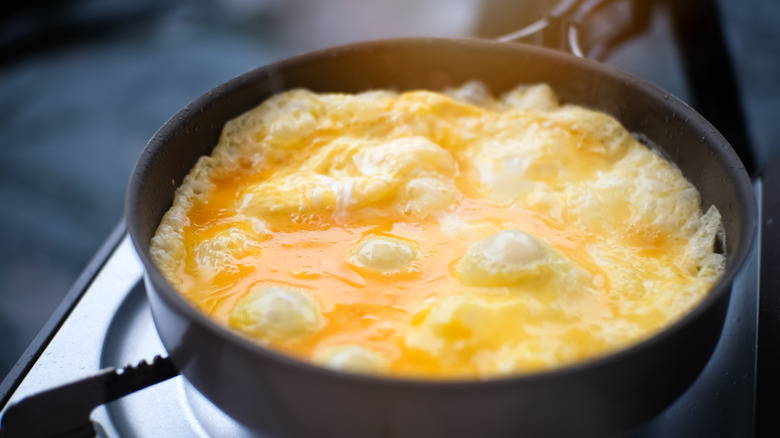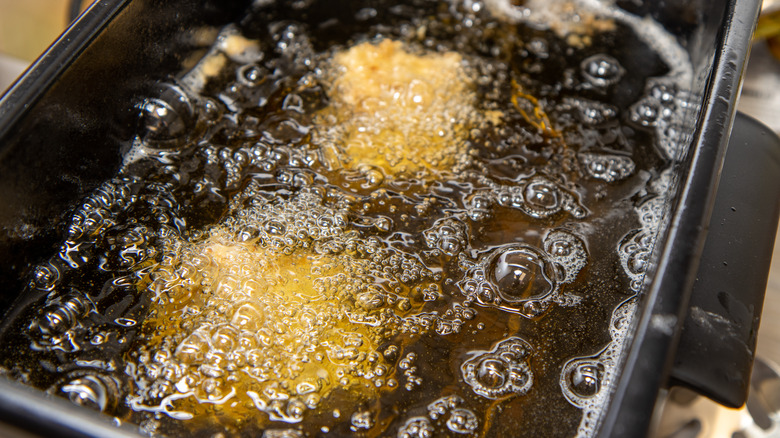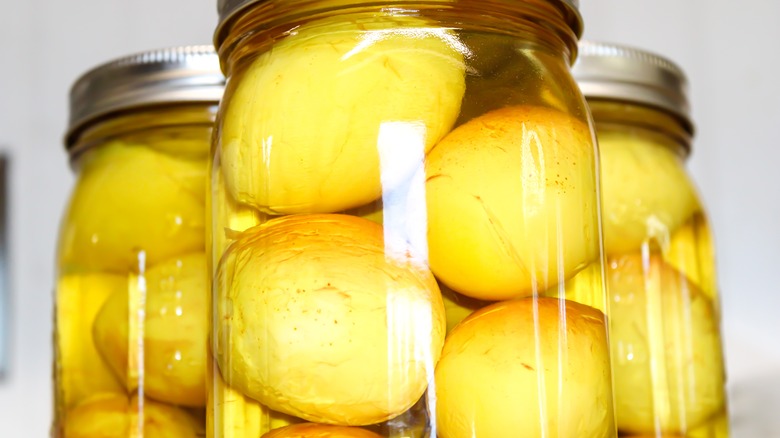7 Healthy Ways To Eat Eggs And 7 Ways You Should Avoid
Eggs are pretty much the staple food for billions of people around the world (via Precision Nutrition). An essential component of everything from breakfasts to salad dressings, sauces, soufflés, fried foods, and a wide variety of desserts (okay, okay, you get the gist) according to Egg Info, in the U.S. alone, a big part of our yearly food bill goes toward eggs, whether that's $85 per person yearly in the Western states, or a slightly more lean $51 per year in the Midwest (per Statista).
But despite the unrelenting demand for eggs, there's a non-stop dialogue surrounding their impact on health. Thanks to their higher cholesterol and saturated fat content, eggs have been cited as an unhealthy dietary choice, even though multiple studies have shown that eating eggs in moderation has no significant negative impact on health, says registered dietitian Samantha Cassetty for NBC News. Having said that, as with any food, there are healthier and unhealthier ways to prepare eggs. And with a food item as infinitely versatile as the egg, it stands to reason that some cooking methods will have you praising their healthful qualities, and others might have you thinking twice about dishing them up every night. Let's take a look at the healthiest and unhealthiest ways to cook eggs.
Healthy: boiled eggs
It doesn't get much simpler than this. Boiled eggs are the go-to breakfast for countless folks, and whether soft-boiled, jammy, or firm, this preparation is one of the healthiest ways you can eat them (via Healthline). When boiling an egg, you're introducing no other factors to the process, such as oil to cook them or other potentially unhealthy ingredients. This means that you get the full whack of the egg's nutritional benefits, with an excellent six grams of lean protein per egg, along with five grams of fat and roughly 77 calories for a large egg weighing around 50 grams (per Healthline).
As a complete protein, a hard-boiled egg contains all of the nine essential amino acids needed to allow the body to perform a number of functions reform damaged body tissue and aid growth, says Medical News Today. Hard-boiled eggs also contain good quantities of vitamins and minerals, including selenium, important to help support the immune system and assist cognitive function (per Medical News Today), vitamins B2, B12, and B5, and phosphorus. Just make sure that you're including the egg yolk when you eat your hard-boiled egg if you're after its nutritional benefits, as the egg white is primarily composed of protein, whereas the yolk contains most of the other nutritional goodness.
Unhealthy: fried eggs
It's an unfortunate fact of life that fried food, while delicious, is also often not the best for you. Such is the case with fried eggs, especially if you're frying them in larger amounts of oil or, potentially worse, butter (via Eat This, Not That!). Frying eggs in too much fat can take away from the natural healthy qualities of eggs, and add in nutritional components that you might rather do without. "As soon as you add butter to the mix, the saturated fat in your dish shoots up. This is something we don't want, as excessive saturated fat in the diet is closely linked to heart disease," states UVA Health's Heart and Vascular Center's registered dietitian Katherine Basbaum to Eat This, Not That!.
And it's not only the added fat content that could be a problem: "Cooking at high temperatures oxidizes oils, and when consumed this can trigger inflammation in the body," warns registered dietitian Rebecca Washuta in the same article. To counteract this, when frying your eggs, make sure you use an oil that can handle higher temperatures, like avocado oil, or cook them at a lower temperature, ideally with a heart-healthy oil (olive or avocado oil both work well here). You can also use a cooking spray or nonstick pan to minimize the amount of oil used and make sure you're pairing your eggs with healthy components on your plate.
Healthy: poached eggs
Now, we're not saying that this is the easiest way to cook eggs (honestly, if anyone can teach us a proper technique for poaching, please help us). But poaching your eggs is one of the healthiest ways to prepare them (via Healthline). Using just the egg and some water to cook it in, poaching will deliver all of the nutrients with no additional unwanted visitors, leaving you merely with the high-protein, low-carb, low-sodium goodness of the egg (per My Fitness Pal). Although eggs are higher in fat and cholesterol, as part of a lower-cholesterol diet they're perfectly safe to eat in moderation, says the Mayo Clinic.
It is worth bearing in mind, though, that anything you add to the water to assist in the poaching process might change the flavor of the egg, as well as the cooking method itself. You might want to avoid salt for this reason, as not only might it make your egg taste a little different, but it may also affect the egg's white, causing it to break up, according to BBC Good Food. Try the whirlpool effect, where you create a vortex in the water with a whisk before dropping the egg into the pan, (hopefully) helping it form a ball shape, says Cooking Light.
Unhealthy: scrambled eggs
So let us caveat this one by saying that there are a lot of situations where scrambled eggs are pretty healthy. When cooked in a non-stick pan, with minimal oil or cooking spray and nothing added to them, scrambled eggs can be a nutritious and healthy breakfast (or lunch, dinner, or snack). It's all in the additions, though. Adding large amounts of higher-fat ingredients like cream or cheese to your scrambled eggs, or cooking them in high amounts of butter, can reduce their nutritional goodness and turn them into a less-than-healthy option, advises SFGate.
On the flip side, however, scrambled eggs can be made even more healthy by adding loads of ingredients full of goodness. Try making scrambled eggs with a few tablespoons of skim milk and throwing in half a cup of torn spinach leaves, and cooking them with cooking spray, as The Spruce Eats advises. The spinach will bulk out the meal and add some much-needed fiber (especially if you serve it with whole-grain toast), as well as boost the phosphorus content of the dish and deliver quantities of calcium, magnesium, and vitamin C, says the University of Rochester Medical Center.
Healthy: steamed eggs
Cooking eggs in their shell usually involves boiling them, but to mix things up, we recommend giving steaming a whirl. Not only is steaming your eggs a perfect opportunity to make more frequent use of that bamboo steamer sitting above your countertops, but the gentler cooking process also means that your eggs will cook slightly slower, giving a more tender end product, says Bon Appétit. They're also less prone to cracking during cooking, and easier to peel (per HuffPost). Crucially, too, as with boiling, steaming cooks your eggs with no additional oils or fats added to the dish.
For newbie steamers, starting with eggs might seem intimidating, but all it takes is a slight adjustment to timings. For a hard egg, place your eggs in a steamer and put it above a pot with around a ½ inch of boiling water, and steam for 10-12 minutes with the lid on, says Bon Appétit. If you like a softer, runnier yolk, reduce your cooking time to 6 ½ minutes, and then immediately dunk your eggs in an ice bath to halt the cooking process.
Unhealthy: soufflé
The soufflé might be the king of the baked-egg dishes and beloved by gourmet chefs worldwide, but all of that tasty goodness can come at a cost. In a traditional soufflé, eggs are the star of the show, but they're combined with a pretty generous amount of butter, flour, milk, and cheese, as seen in Gordon Ramsay's classic soufflé recipe via BBC Good Food. While all of these ingredients can be okay in moderation, the butter, cheese, and milk used can add further saturated fat and cholesterol to your diet (per the British Heart Foundation). Adding refined white flour to the eggs can also cause a spike in blood sugar and insulin, and provides carbohydrates but without good amounts of healthy fiber, as WebMD states.
But all is not lost yet for soufflé lovers. With a few simple adjustments, it's entirely possible to enjoy soufflés while keeping them on the healthy side. Sub out whole milk for fat-free and reduce the amount of cheese in your dish, while adding healthy garlic and fiber-rich spinach to amp up your soufflé's nutrients, advises the American Heart Association. Their recipe also removes some of the egg yolks from the dish to bring down its cholesterol content, and uses low-sodium whole-wheat breadcrumbs.
Healthy: baked eggs
In the realm of egg dishes, those that are baked (i.e., in cakes) are probably the ones that health-conscious eaters shy away from the most. But it all depends on the form it takes, and in its root form, baking is a super-healthy way to cook. Baking utilizes hot air to cook food and, in theory, requires little-to-no addition of oil, as the World Cancer Research Fund points out.
As such, baking eggs can be as simple as cracking them into an oven-proof dish with some other healthy ingredients to get the most from their rich content of vitamins A, D, and E, iron, protein, and antioxidants, says Egg Info. To maximize the nourishing nature of a baked egg dish, begin by slicing up some peppers, zucchini, eggplant, garlic, and herbs, place them in a dish with a little healthy olive oil, and roast them for around 20 minutes at 400 degrees Fahrenheit to soften them up. Take them out of the oven, mix in some black olives, and crack two eggs on top of the vegetables, creating a little space for them to nestle in. Bake for ten more minutes and serve. The vegetables will add much-valued fiber and vitamins to the dish, with the eggplant, in particular, may help support heart health and cholesterol management, and provide a source of the antioxidant nasunin, which aids with nutrient processing (per BBC Good Food).
Unhealthy: quiche
Ah, yes. The quiche. So succulent, so delicious, and so the opposite of everything we're told is good for us in food. As well as the fact that common ingredients that frequently accompany eggs in a quiche (like cheese, bacon, and cream) aren't exactly the healthiest components of a dish out there, there's also the small matter of the delectable pastry it all comes encased in (via SFGate). And it's even worse if you're making a quiche with processed pastry, advises registered dietitian Keri Glassman via Today. Pre-packaged pastries can often be loaded with refined flour and trans fats, which can negatively impact cardiovascular health and increase diabetes risk. They can also contain numerous other artificial ingredients and preservatives used to extend shelf life.
While these preservatives may not be harmful in themselves (although some common preservatives can be harmful to children, as Harvard Health Publishing points out), it could be better to make your own. And by making a quiche yourself with a healthy crust comprised of whole-wheat flour and olive oil, it might be possible to still enjoy the dish without worrying about the health consequences too much, says Eating Well. Or, you can forego the crust altogether. In either case, make sure you're filling your quiche up with lean protein and fiber-rich vegetables, and avoid using cream, subbing it out for low-fat milk.
Healthy: microwaving eggs
Your microwave oven can be used to cook pretty much anything, but too often it's relegated to a machine that's solely used to reheat old takeout. Well, we're here to fly the flag for the microwave as a healthy cooking method, and it starts with eggs. Cooking eggs in the microwave can help to keep them more nutritious compared with other cooking methods, thanks to the speed they cook at. "You can lose anywhere from nothing to 80 or 90% of nutrients with conventional types of cooking like roasting, boiling, or frying, but with microwaves, you raise the temperature much faster, so the nutrients are subjected to heat for less time," explains certified food scientist Guy Crosby to Men's Journal. Specific nutrients, like vitamin B2 and folic acid, which are present in eggs (per Egg Info), also tend to maintain their quality better when cooked in a microwave, so you get more of their goodness.
But how exactly do you go about cooking eggs in a microwave? It's pretty simple. Using the microwave to poach eggs can be achieved by cracking an egg into a microwave-safe container, adding a ⅓ cup of water, covering it with a plate, and nuking it for a few minutes, says Sauder's Eggs. Whisking up eggs in a mug and microwaving them is also a super-quick way to make scrambled eggs even easier.
Unhealthy: traditional deviled eggs
No picnic or family gathering is complete without deviled eggs, in our opinion. Yes, they might be retro, but come on folks, they're tasty. But one of the reasons why they're a level up from a plain old boiled egg — the addition of mayonnaise to the egg yolk — is also why they can fall on the unhealthy side. Mayonnaise isn't a terrible ingredient in itself (it's made of egg, after all, which you're eating with a deviled egg anyway), but it is a foodstuff composed mostly of oil and fat, as Verywell Health discusses. Those looking to reduce their fat or calorie intake may want to steer away from it for this reason — but watch out if you're swapping it out for low-calorie mayo, as it can often contain sugar or starches to help bolster its taste, leading you to ingest potentially unwanted carbs.
If you're still craving deviled eggs, though, we have a healthy fix for you: Try using Greek yogurt instead of mayonnaise, as Live Eat Learn suggests. The yogurt will add further protein to the dish, bolstering the protein content of the eggs. Greek yogurt is also a great source of calcium, selenium, and riboflavin, and can help support gut health with its probiotic qualities, Healthline says.
Healthy: omelet
To us, omelets look pretty much like the perfect food: nutritious, cheap, and infinitely customizable. Unfortunately, they also get a pretty bad rep for not being the healthiest of foods, due to the butter traditionally used to cook them and finish them off, as Bon Appétit shows, which can send their saturated fat content skyrocketing (via WebMD).
But wait! An omelet needn't be buttered up to be delicious. With a few judicious ingredient choices, such as using olive oil to cook the egg and adding in mushrooms and kale, you can create an omelet that's irresistible and healthy, advises Cooking Light. Including kale will send your omelet's nutritional composition into the stratosphere, with the leafy green providing huge amounts of vitamins K, C, and A, an ample dose of antioxidants, and a strong boost of fiber, says Healthline. Using a non-stick pan to cook your omelet can also assist in keeping things healthy, as you'll require less oil overall.
Unhealthy: deep-fried eggs
Okay, so if we're being honest, we know that deep-frying isn't the most common way to cook an egg. But honestly? We think there's a good reason for that. On a basic level, deep-frying eggs is pretty simple — all it takes is some eggs and a whole lot of oil, according to Delicious From Scratch. But deep-frying eggs — deep-frying anything – is a surefire way to make things a little less healthy. "When foods are fried they become more calorically dense because the outer part of the food loses water and absorbs the fat [or] oil," says registered dietitian Ashley Kitchens to Eat This, Not That!. Not only that, but depending on the type of oil you use to deep-fry food, you could be loading your dish with trans fats, which Kitchens notes can boost your bad cholesterol (or LDL) levels.
So, instead of deep-frying your eggs, we'd recommend frying them with a little heart-healthy oil or cooking spray in a non-stick pan. Just make sure to control the amount of oil you're using, as being too generous can turn your dish into a deep-frying affair unintentionally.
Healthy: Greek yogurt egg salad
How do you make an egg healthier? Turn it into a salad! No, we promise there's not a joke in there that you're missing — an egg salad is an excellent way of enjoying eggs while sneaking in some added veggies.
However, it's all in the prep. Although store-bought egg salads are convenient, they can often be loaded with mayo and other fats (via Food Network). But by making egg salad at home, you can control the salt and fat content, and sub out mayo for a healthy substitute like Greek yogurt. The calcium content in Greek yogurt can help contribute to bone health and reduce the risk of bone-related conditions, and its protein will add to the amount you're already getting from the eggs, helping to fuel muscle growth (per Medical News Today). Simply combine four hard-boiled eggs with ¼ cup of Greek yogurt, some lemon juice, and dill, and season to taste, says Bowl of Delicious. As an added nutrient bonus, and to make the dish go further, try throwing in some chopped celery or green onion. Serve on its own, with lettuce wraps, over some healthy salad leaves, or on whole-wheat bread as a sandwich.
Unhealthy: pickled eggs
A pickled egg is a bar staple, and those who have been brave enough to order one from that big jar on the counter are rewarded with its sharp, tangy, delectable taste. But while pickled eggs are a seemingly healthy choice (it's just a hard-boiled egg, right?), the brine that's used to create them may have an unintentional impact on your health. Salt-heavy brine can add a surprisingly large amount of sodium to a pickled egg, with a single egg delivering roughly 18% of your daily sodium recommended intake, as Eat This Much points out. High-sodium diets have been consistently linked with higher blood pressure, and increased rates of heart attack and stroke, per the Centers for Disease Control and Prevention.
With approximately 90% of Americans over the age of two years old eating too much sodium, trying to find ways to reduce our intake is important, and cutting down on pickled eggs (and other pickled products) may be the way to do so. Eating a hard-boiled egg with a smidge of salt and vinegar sprinkled on top is a good way to still enjoy the taste of a pickled egg while controlling your intake.

